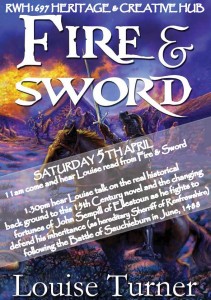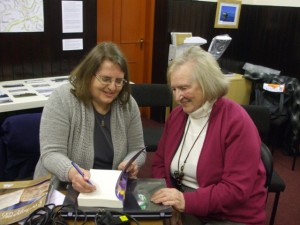So here we have it! My second blog hop of the day…
This time, I must say a big ‘thank you’ to Margaret Skea for inviting me to take part. It’s quite an appropriate chain of succession, because Margaret’s debut historical novel, Turn of the Tide, is set in late 16th century Ayrshire, and has at its heart the infamous feud between the Montgomerie and Cunninghame familes, the roots of which are explored in Fire & Sword, and indeed in its follow-up, which I’ll tell you a bit more about below! So please check out Margaret’s website at http://www.margaretskea.com – or better still! – buy her book if you fancy reading another unique take on the Montgomerie/Cunningame saga.
1) What is the name of your main character, is he/she fictional or a historical character
Since I’ve been tagged by the author of a novel which features the Montgomeries so prominently, I thought it only right to give pride of place to the anti-hero of my debut novel, Fire & Sword, Hugh, 2nd Lord Montgomerie, who steps forward into the limelight for the follow-up.
He’s based on a real historical figure: Hugh, 2nd Lord Montgomerie, later 1st Earl of Eglinton. Hugh, 1st Earl of Eglinton was the great-grandsire of Hugh, 4th Earl of Eglinton, who features albeit briefly in Margarent Skea’s novel. I don’t think I’m giving anything away of Margaret’s novel by telling you that Hugh, 4th Earl was assassinated by the Cunninghames in the late 1580s, marking the nadir of the feud. It’s an appropriate event to mention here, because arguably it was the way in which Hugh, 2nd Lord/1st Earl, conducted himself that had such dire repercussions for his descendant.
2) Where and When is the story set?
My novel’s set in Scotland, in the period between 1489 and 1490. King James IV has not long succeeded to the throne following the murder of his father James III at the Battle of Sauchieburn in June 1488. Try as he might, James just can’t get a grip of his kingdom. He’s struggling to contain a rebellion led by John Stewart, Earl of Lennox and he’s reliant upon his local officials to try and calm things down and create some kind of peace throughout the land. In Renfrewshire, he has men like Sir John Sempill (newly won over from the opposing side) making a sterling effort to restore justice and prosperity. Elsewhere he’s forced to rely on men like Hugh, 2nd Lord Montgomerie, who just can’t seem to get their act together, succeeding only in generating yet more chaos in their efforts to rein in those who work against them.
3) What should we know about him or her?
When I first started to explore the ‘real’ Hugh’s character, I thought, “Clearly, he’s a psychopath.” But as I delved more deeply into the documentary evidence, I realised that the truth was much more complex. He’s certainly given short shrift by historians – I’ve heard him described variously as ‘hawkish’, ‘the appalling Hugh Montgomerie’, and ‘what a b*****d!’ by notable worthies in the field!
The ‘real’ Hugh, 2nd Lord Montgomerie (created 1st Earl of Eglinton in the early 1500s) was born in 1458 and died in 1545 at the grand old age of 87. He appears to have been an accomplished courtier, who was appointed to the Privy Council (briefly!) in 1489. After a spectacular fall from grace (explored in my second novel), he never really regained his earlier success until the post-Flodden period when he became an elder statesmen almost by default when he was one of the few senior figures to survive (or avoid) the Battle of Flodden. It was at this time, in the reign of James V, that he held a number of distinguished offices at the Scots court , including Justice General of the North and Acting Vice-Regent before finally retiring from active politics aged 78.
Unfortunately, he’s best remembered locally for his persistent habit of bumping off his enemies. The first recorded incident was the murder of James, 2nd Lord Boyd (then aged 15) somewhere near Stewarton, Ayrshire, in 1483. Hugh was acquitted of this crime, but after this initial incident he seems to have been responsible (in one instance, personally responsible) for the deaths of two consecutive heads of the rival Cunninghame family. His marriage to one of the daughters of Colin, 1st Earl of Argyll, head of the powerful Campbell clan, may do much to explain his brutal, uncompromising methods; as a young man, he certainly appears to have spent some time in Campbell’s household.
Hugh Montgomerie as I’ve portrayed him in my writing is impulsive, determined, and in our modern understanding, a bit bipolar. He lives by the motto, “Act in haste, repent at leisure.” If you catch him on the wrong day, in the wrong mood, you’ll be bludgeoned aside with absolutely no second thought. If he happens to be armed at the time, then your mistake will probably be a fatal one. In Fire & Sword, John Sempill says of Hugh, “He’s not a man; he’s a force of nature,” and John – who’s more perceptive than most – has probably got it spot on!
4) What is the personal goal of the character?
Hugh’s driven by insecurity. He comes from a very worthy lineage – one of his ancestors fought at The Battle of Otterburn and defeated the famous ‘Hotspur’ following the death of the James, 2nd Earl of Douglas. With Hotspur’s ransom, the Montgomeries built Polnoon Castle, which became their family seat until Hugh, 2nd Lord/1st Earl moved it to Eglinton, near modern Kilwinning. As for the duel itself, it subsequently became immortalized in the Ballad of Chevy Chase.
Hugh had his ancestor’s formidable reputation to live up to, but also had the misfortune to get off to a very shaky start when he was orphaned before the age of 12. At this age, he inherited his lands and titles directly from his great-grandfather. With no other senior relatives surviving, I suspect his wardship was purchased from the king (James III), as was customary at the time. Unfortunately we have no way of knowing exactly whom had this privilege, the only evidence coming in the form of a very testy document issued by Hugh when he reached his perfect age, stating that all grants made previously in his name are to be considered null and void.
It’s my hunch (the historian in me cannot, unfortunately, back this up!) that Hugh was fleeced during his minority, and I also suspect that whoever these individuals were, they didn’t want to let go once their ward achieved maturity. Perhaps the Montgomeries’ infamous feud with the Cunninghame family began at this time – it’s quite possible Hugh was the Cunninghames’ ward (as well as being a respected local family, they were related to the young Hugh and would therefore have been a perfectly appropriate choice). I’m inclined to think it was Hugh’s own personal sense of grievance at these injustices (real or imagined) that originally fuelled the vendetta. Certainly, he’s a man who went through life with a massive chip in his shoulder – unfortunately for the Cunninghames, he was also gifted with the drive, the ambition and the energy to do something about it!
5) What is the main conflict, what messes up his or her’s life?
Hugh would like us all to think that his life is messed up on account of those dastardly Cunninghames, but in reality he’s his own worst enemy. By the end of the events depicted in Fire & Sword, he’s got everything going for him. He’s a Privy Councillor, he’s a favourite of the King, and all these legitimate grievances that drove him (so he’d argue) to rebel against the previous king have been dealt with. It’s true that he’s made enemies, but I think if he’d responded against these threats in a more subtle and careful manner, he could have won through the crisis with his reputation intact. Instead, his habit of blundering onwards like a bull at a gate cost him a promising political career at the court of James IV.
6) Is there a working title of this story and can we read more about it?
The working title is The Gryphon at Bay – I used this because the Gryphon/griffin is the supporter of the Montgomerie coat-of arms. It has the added advantage of being an ambiguous creature in heraldry & mythology. On the one hand, it symbolizes positive qualities such as wisdom and nobility, while at the same time it can be viewed as embodying the perversion of these qualities. Griffins are associated with the goddess Nemesis (who is linked vengeance and retribution) and they can sometimes also be associated with the Devil or the Anti-Christ. Given Hugh Montgomerie’s dual nature (a man you hate to love!) it seemed perfect to make reference to the griffin/gryphon in the title.
The work is completed, and awaiting submission to my publisher, but nothing’s in circulation as yet. If your interest has been piqued, then I’d recommend getting hold of Fire & Sword, where we first meet Hugh and where we learn a great deal about what those around him think of him.
i’m also working on a couple of short pieces of fiction – featuring both John Sempill and Hugh Montgomerie – which will probably be in circulation sooner. No information is available as yet, but as the old saying goes – watch this space!
7) When can we expect the book to be published?
Unfortunately, my lovely editor at Hadley Rille Books – Eric Reynolds – has recently suffered some major health issues. As a result, publication schedules are wa-a-a-y behind, so I have no idea when things will be moving forward.
Now it’s time for me to hand over the proceedings to the next batch of participants. I’m not sure whether this blog hop started out primarily for authors of historical fiction – if so, then I’m taking the liberty of broadening the catchment, by including a couple of fantasy writers. So can I introduce you to next week’s bloggers: poet and author Judi Sutherland (www.judisutherland.com ), historical fiction writer Juliet Waldron ( http://www.julietwaldron.com ) and also my fellow HRB authors Karin Gastreich (http://eolynchronicles.blogspot.com )and Mark Nelson (http://hrbpress.com/authors.htm) .


